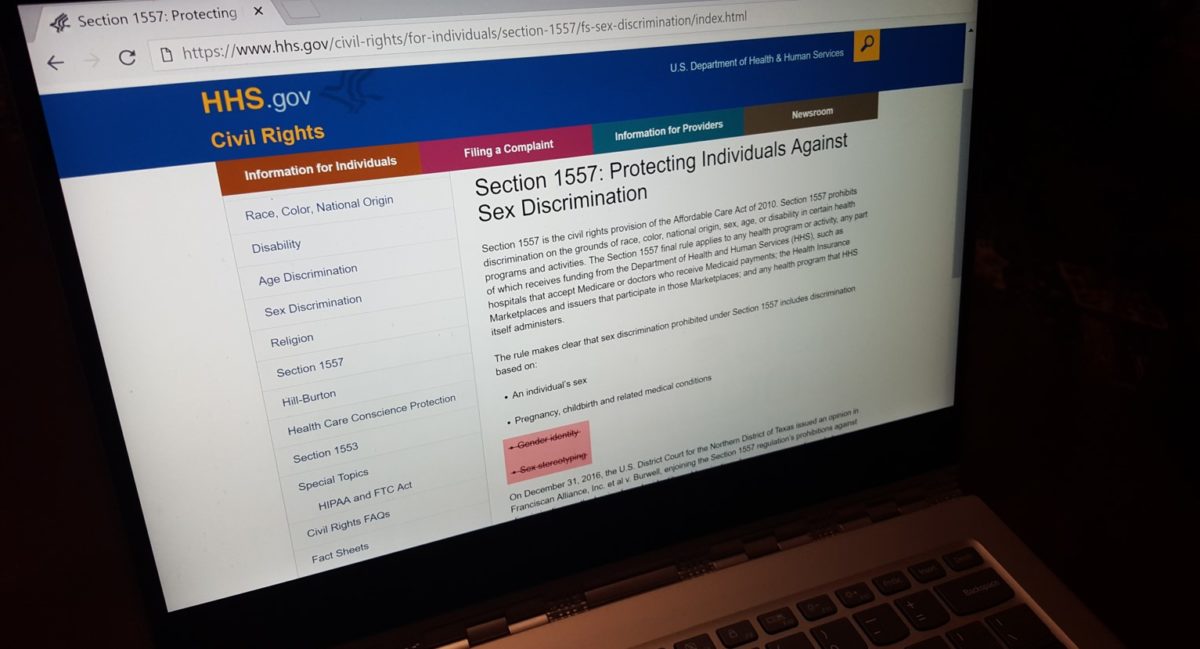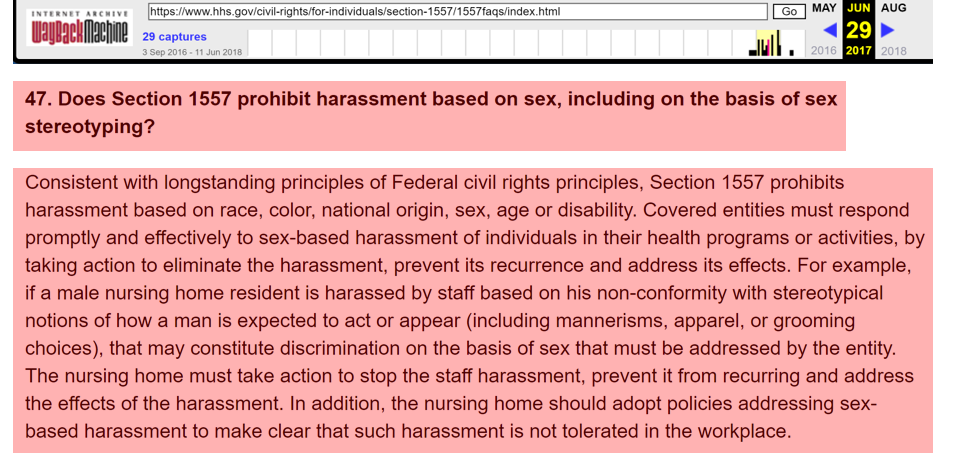HHS removes sex discrimination prohibition language from civil rights office website

The Department of Health and Human Services’ Office for Civil Rights has altered messaging on its website related to Section 1557, the provision of the Affordable Care Act prohibiting discrimination, including sex discrimination. Advocates and experts say the changes to informational webpages about Section 1557, detailed in the latest Web Integrity Project report, could foreshadow a shift in policy regarding the prohibition of sex discrimination as the Department of Health and Human Services (HHS) prepares to release new regulations as soon as this month.
The report documents changes in language pertaining to sex discrimination on the Office for Civil Rights (OCR) website, first discovered by staff at the National Women’s Law Center (NWLC), as well as the reduction in access to training materials about Section 1557 for health and healthcare professionals. NWLC, which released a fact sheet about Section 1557, has filed a series of still-pending FOIA requests for information about why these changes were made to the website.
Section 1557 has been the focus of a long-running legal battle over whether OCR, the office responsible for enforcing regulations stemming from 1557, can respond to complaints of discrimination against transgender and gender nonconforming individuals. HHS had determined that the text of Section 1557 allowed it to prohibit all forms of sex discrimination, including discrimination based on an individual’s sex, pregnancy, gender identity, and sex stereotyping, and it put in place these Section 1557 regulations to do so.
HHS’s ability to implement the Section 1557 regulations, however, was limited after a lawsuit by religiously affiliated healthcare providers argued that they would “require them to perform and provide insurance coverage for gender transitions and abortions,” according to court records. In December of 2016, the federal court in Texas hearing the case issued a nationwide preliminary injunction that prevents OCR from enforcing Section 1557 protections against discrimination based on gender identity and termination of pregnancy, without affecting protections against other forms of sex discrimination.
That lawsuit is ongoing, but experts told WIP that the documented changes to the OCR website seem to go well beyond what the injunction requires. First, language on the OCR webpages about Section 1557 has been removed such that, while the pages do still refer to sex discrimination on the basis of an individual’s sex and pregnancy, they no longer explicitly state that sex stereotyping and discrimination on the basis of gender identity are prohibited. Second, after language was added to the webpages to explain the outcome of the injunction, some of the language was later removed that explicitly stated that, even with the injunction in place, OCR can still enforce prohibitions on sex stereotyping and discrimination on the basis of one’s sex.
 A question and corresponding answer were removed between June 29, 2017 and August 18, 2017 from OCR’s “Frequently Asked Questions” page, according to the Internet Archive’s Wayback Machine.
A question and corresponding answer were removed between June 29, 2017 and August 18, 2017 from OCR’s “Frequently Asked Questions” page, according to the Internet Archive’s Wayback Machine.
Jocelyn Samuels, who served as the director of OCR until January of 2017, is now the executive director of the Williams Institute on Sexual Orientation and Gender Identity Law and Public Policy, which works on issues relating to Section 1557, at the University of California, Los Angeles School of Law.
Samuels says these changes have, “a damaging impact, because the existence of this language … was intended to inform those subject to discrimination that they continue to have rights,” regardless of “impressions they may have gotten about the injunction based on press releases.”
As we detail in our report, webpages such as the Section 1557 FAQ, which have been preserved by the Internet Archive’s Wayback Machine, were changed to include text explaining that the injunction enjoins OCR from “enforcing Section 1557 regulation’s [sic] prohibitions against discrimination on the basis of gender identity and termination of pregnancy on a nationwide basis.”
But, as noted above, text that explained how Section 1557 defines sex discrimination more broadly, specifically on the basis of gender identity, was also removed. For example, OCR removed the text “under the final rule, categorical coverage exclusions or limitations for all health services related to gender transition are discriminatory,” and additionally removed text that explicitly stated that, “the law … prohibits discrimination against transgender individuals.”
Kelli Garcia, director of the Reproductive Justice Initiative at National Women’s Law Center, explained that these language removals were much more sweeping than necessary under the injunction, “which halted HHS’s enforcement but did not change the underlying statute and what the law actually means.”
Garcia’s colleague MiQuel Davies, a fellow at NWLC, said the altered information could mislead readers by defining sex discrimination in “extremely narrow” terms that don’t reflect the way courts have previously approached the concept. For instance, while the regulations still prohibit sex stereotyping under provisions not affected by the injunction, our report notes that OCR removed all language about “sex stereotyping” from its webpages about Section 1557. Referring to a 1989 case that defined stereotyping based on someone’s sex or gender as a form of sex discrimination, Davies said that by removing this language, OCR is “calling into question the Supreme Court’s interpretation of what it means to discriminate against someone based on sex stereotypes.”
Additionally, the website, after being changed, now simply states that OCR “will continue to enforce … sex discrimination provisions that are not impacted by the court’s order.” The court has not enjoined OCR from enforcing the Section 1557 regulations’ prohibition on sex stereotyping, as Garcia pointed out, but, without a stated definition of sex discrimination and an explicit statement about which provisions are not impacted by the injunction, OCR is not making clear to the public that it still has that power.
OCR also removed other important content related to the Section 1557 regulations, including links to training materials about Section 1557 and case examples of OCR’s enforcement of prohibitions on sex discrimination, as noted in our report.
Davies explained that “covered entities, hospitals, people who have to comply with the healthcare rights law are going to look at examples of enforcement to know, do we need to protect on these grounds? What are our obligations?” By removing the case examples, which demonstrate how enforcement was conducted, the office is failing to offer guidance to people and organizations who may need it.
On June 25, HHS filed a status update to the Texas court, stating that it is “reevaluating the reasonableness, necessity, and efficacy of the Rule that is challenged in this case” and asking the court to maintain the injunction. The rule being suggested by HHS in the update, which might roll back all or part of the current 1557 regulations, won’t be made public until after its publication in the Federal Register, at which point HHS will begin accepting public comment.
“Removing this language doesn’t change the legal rights that people have,” Samuels said. “But it certainly suggests that OCR is not intent on informing people about the extent of the rights they continue to have.”

